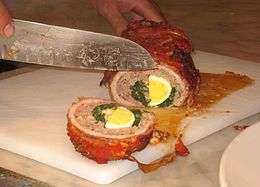Farsu magru
Farsu magru, also spelled as farsumagru, and also referred to as farsumauru, falsomagro and falsumagru, is a traditional meat roll dish in Sicilian cuisine that dates to the 13th century.[1][2] Farsu magru is available in many areas of Sicily, but some only serve it for special occasions.[2][3][4] This roast is prepared mainly in rural regions in the interior of the island. Farsu magru means " false lean", which has been attributed to the amounts of meat used in the dish, and also to the lean, low-fat nature of the meats typically used.

Etymology
Farsu magru means "false lean", meaning "lean" in the sense that a relatively small amount of meat ingredients are used to prepare the dish, which is otherwise substantial in size.[1][5] The "false lean" moniker has also been described as representative of how the lean, low-fat cuts of meat that are typically used in the dish contrasts the stuffing, which has a higher-fat content.[2][3]
History
Farsu magru dates to the 13th century in Sicily, during the time of the Angevin invasion of the island.[3][4] It has been stated that the dish's name is based upon the French word farce, which means "stuffing".[4] During this time, farsu magru was a simpler dish, typically prepared by simply rolling meat around bread crumbs.[4] As time passed, the dish became more complex, with the addition of more ingredients.[4]
Preparation
Farsu magru is prepared with beef or veal slices that are flattened and superimposed to form a large rectangle.[6] On top of this is a layer of thin bacon slices. For the filling, crushed bread slices, cubed cheese and ham, chopped onions, garlic and fresh herbs are mixed together.[1][7][6] Subsequently, the filling is evenly distributed, and hard boiled eggs are laid in the middle.[1] The meat is then rolled around the eggs, tied together and cooked in an oven.[1] The dish can also be cooked by poaching.[2][6] It is topped with tomato sauce or tomato purée.[1]
Service
The dish is typically sliced after cooking occurs.[5] In Sicily, farsu magru is sometimes served at room temperature, along with a fennel salad.[1] Some Sicilians only serve the dish during special occasions.[3][4]
See also
References
- Goldstein, J. (2004). Italian Slow and Savory. Chronicle Books. p. 174. ISBN 978-0-8118-4238-9. Retrieved June 15, 2017.
- Stevens, M. (2004). All About Braising: The Art of Uncomplicated Cooking. W. W. Norton. p. 238. ISBN 978-0-393-24118-1. Retrieved June 15, 2017.
- Conte, A.D. (2013). Gastronomy of Italy: Revised Edition. Pavilion Books. p. 306. ISBN 978-1-909815-19-3. Retrieved June 15, 2017.
- Helstosky, C. (2009). Food Culture in the Mediterranean. Food culture around the world. Greenwood Press. p. 100. ISBN 978-0-313-34626-2. Retrieved June 15, 2017.
- Times, Los Angeles (April 25, 2010). "Recipe: Farsumagru (Rolled Steak, Stuffed Sicilian Style)". Los Angeles Times. Retrieved June 15, 2017.
- Fort, M. (2009). Sweet Honey, Bitter Lemons: Travels in Sicily on a Vespa. St. Martin's Press. pp. 49–50. ISBN 978-0-312-55918-2. Retrieved June 15, 2017.
- Philpott, D. (2016). The World of Wine and Food: A Guide to Varieties, Tastes, History, and Pairings. Rowman & Littlefield Publishers. p. 383. ISBN 978-1-4422-6804-3. Retrieved June 15, 2017.
Further reading
- Eufemia Azzolina Pupella: Die Sizilianische Küche. Casa Editrice Bonechi, Florenz 1996, ISBN 88-8029-598-5.
- Chris Meier u. a.: Sizilien. Kulinarische Reiseskizzen. Hädecke Verlag, Weil der Stadt 1997, ISBN 3-7750-0307-X.